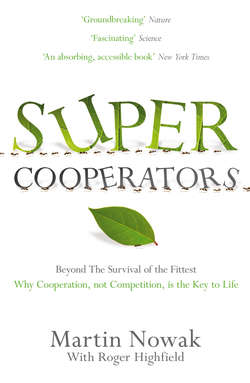Читать книгу SuperCooperators - Roger Highfield - Страница 28
На сайте Литреса книга снята с продажи.
KAHLENBERG
ОглавлениеI first came to appreciate the power of indirect reciprocity on a walk with Karl Sigmund in the summer of 1996. We were hiking around the Kahlenberg, a forested hill north of Vienna. The ridge is blessed with breathtaking views of the great city, being part of the Wienerwald, the Vienna woods. We were negotiating a chain of tree-covered hills northeast of the city, bounded by rivers, including the Danube. There are villages here and there, such as one where Beethoven lived (Nussdorf), and taverns (Heurige) are dotted all about, where we could sit down to sip the local wines.
Although this does not sound a likely birthplace for a scientific breakthrough, there is plenty of evidence that the networks of paths that crisscross the forested hills of the Wienerwald are steeped in creative magic. Mahler would walk from the Kahlenberg into the city to conduct opera. Johann Strauss the Younger composed his “Tales from the Vienna Woods” in waltz time. Franz Schubert and Beethoven were also moved by its rolling Arcadian landscapes. A green meadow on a plateau high above the city where the skies open wide is called Himmel (Heaven). There, the young Sigmund Freud managed to convince himself that he had understood the nature of dreams.
During our long meander though heaven, Karl mentioned something that made me stop in my tracks. He suggested that we should extend our work on cooperation to take a close look at indirect reciprocity. I had never heard that expression before but so many thoughts gushed into my mind that I found it intoxicating. I told him that I did not want him to explain too many details. I did not want to know what work might have been done before on this subject, so I could follow through my own line of thinking. I knew exactly what he meant and how the perfect clarity of mathematics could bring this idea into sharp focus. I stopped everything else that I was doing. In my mind a rolling landscape of new possibilities for cooperation beckoned.
I fell in love with this work, which I felt would take our research in a new direction. I was almost consumed by the feeling. Amour did seem to be in the air. For one thing, I was reading The English Patient (“In love, there are no boundaries”). For another, Karl and I had made a poignant discovery during our walk in the lush greenery of the Wienerwald. We stumbled across a little cemetery, where there was an overgrown grave. The headstone was carved with poems and stories to celebrate the memory of Caroline Traunwieser, apparently the greatest beauty of the Vienna Congress of 1815.
Among the many dedications to Caroline was a tribute from the founder of the Austrian Academy of Sciences, Freiherr von Hammer-Purgstall, an Orientalist scholar who supplied Goethe with Persian poetry. He recounted his first heart-skipping encounter with her in a salon: “Never before and never afterwards in my life was I so overwhelmed by the appearance of beauty.” She was adored by all, from poets to officers to the director of the Viennese China Factory (Wiener Porzellanmanufaktur). Her grave revealed that she died young and that no portrait of her survived. In a strange way, Karl and I felt bereft after reading these moving tributes to her lost beauty. My melancholy was a faint reflection of Caroline’s radiant glow that had illuminated Vienna long ago, a testament to her reputation.
